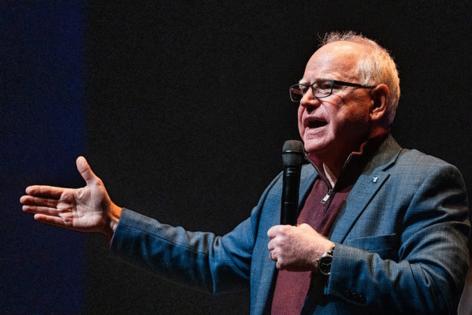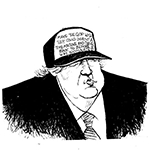Gov. Tim Walz wants Democrats to fight the Texas gerrymander. Minnesota shows why that may be difficult
Published in News & Features
Minnesota Gov. Tim Walz wants Democrats to be aggressive in fighting Republican efforts in Texas to redraw the state’s political maps and give the GOP an advantage in the midterm battle to control Congress.
Walz is encouraging governors in states such as California to combat the GOP effort, being led by President Donald Trump, by creating new districts in their states that Democrats can win. And House Minority Leader Hakeem Jeffries has singled out Minnesota as one of the handful of states where Democrats are exploring redistricting plans.
“In this situation, if California is going to have to respond to Texas they’re going to have to,” Walz said Wednesday from FarmFest in southern Minnesota. “It is bad for democracy, it’s bad for the country, but what’s worse for the country is a totalitarian president who gerrymanders districts in his favor with no response from us.”
But the approach to fight fire with fire has its limitations, Walz acknowledged, including in Minnesota, where decades of split-party control have kicked the redistricting process to the courts.
Minnesota’s Legislature, which oversees the state’s redistricting process, is currently divided between the DFL-led Senate and a state House that’s expected to return to a 67-67 tie after a September special election.
Redistricting experts in Minnesota say redrawing congressional maps here would be exceedingly difficult if Democrats try to push any plan forward. A redistricting committee would need to be formed and any plan would have to pass both chambers in the Legislature.
“The most obvious impediment to it is the House is tied,” said Minnesota Republican strategist Gregg Peppin, who sat on the state’s Republican redistricting team in 2000. “There’d be no way that a plan would get through.”
Peppin noted the state’s Constitution spells out that redistricting is supposed to take place after the U.S. Census, a once-every-decade national population count. The last time Minnesota redrew its political maps was following the 2020 Census.
“It doesn’t specifically prohibit mid-decade redistricting, but I think any effort would be fraught with court challenges,” Peppin said. “There’s other states where it’s more plausible. I don’t see Minnesota being one of them.”
A redistricting effort could have possibly been carried out last year, when Walz and legislative Democrats controlled state government, said political science Professor David Schultz, who specializes in election law.
But divided government is what’s plagued lawmakers from competing their own redistricting maps over the years in Minnesota, forcing the courts to step in and appoint a panel to draw the lines.
“There has been a sufficient deadlock, either split legislative control, or the Legislature and governor are not of the same party,” Schultz said. “What has wound up happening here is that it’s been turned over to the Minnesota Supreme Court.”
The Minnesota Supreme Court’s role in redistricting is also what’s likely led to Minnesota’s political boundaries being drawn in a more bipartisan way and free from gerrymandering, Schultz said. Judges have adopted a “minimalist strategy” when it comes to adjusting them.
“They operate from the current lines, adjust them a little bit, and have not been willing to dramatically alter the landscape,” he said.
Political geography also makes it challenging for Minnesota to significantly redraw its maps.
Democratic states like New York and California, which have been leading the opposition to Republican redistricting plans, both have more than a dozen congressional districts.
Minnesota has just eight, which would also make adjusting the boundaries of the current districts more difficult than it is in states with more congressional districts to work with.
“In Minnesota, Democrats are very compactly fit into an area that is basically defined by 694, 494 Beltway and maybe 10 miles outside that. Everything on the inside of what I just described is very Democratic,” said Todd Rapp, a former DFL legislative staffer and campaign operative, who helped lawmakers work on redistricting plans.
“Nearly all the rest of the state, with the possible exception of Duluth and Rochester and maybe Mankato, is Republican,” Rapp added. “That really limits how many ways you could redraw the districts.”
Walz, who said he’s backed nonpartisan redistricting since his days in Congress, acknowledges the burden will have to be on other blue states to counter the GOP.
“We’re not dealing with a normal situation, we can’t on this say: ‘When they go low, we gotta go high,’” Walz said. “When they violate the law and gerrymander, if we don’t do something about this, they are going to game this system, take these votes away, and potentially switch a midterm.”
_____
(Minnesota Star Tribune reporter Allison Kite contributed to this story.)
_____
©2025 The Minnesota Star Tribune. Visit startribune.com. Distributed by Tribune Content Agency, LLC







Comments